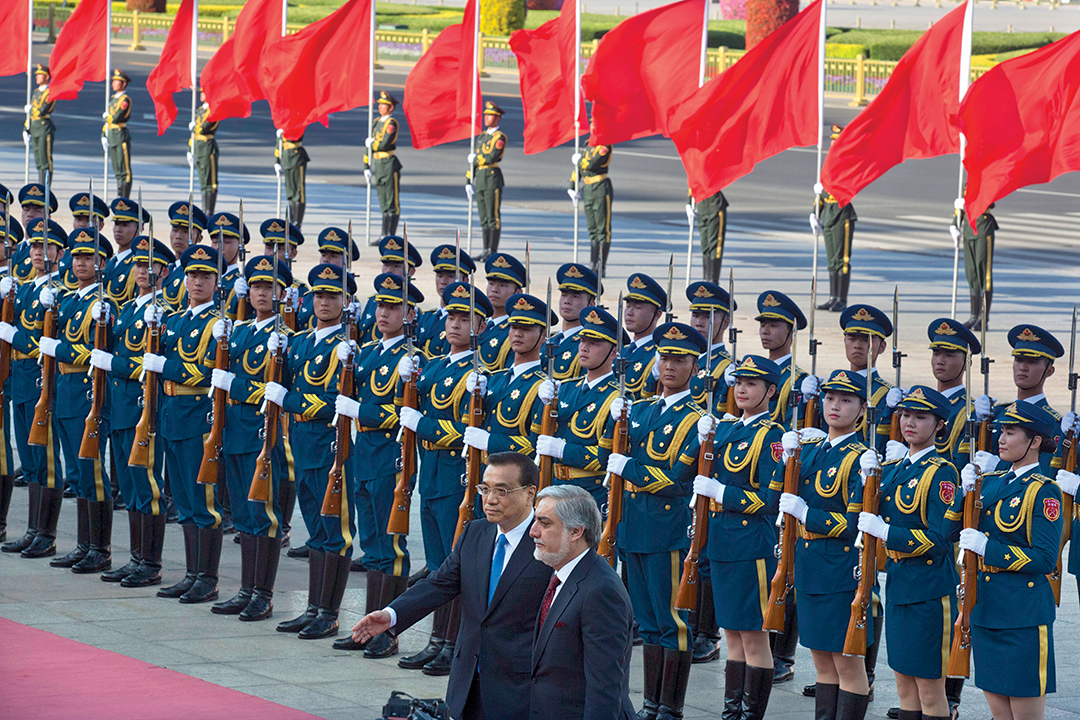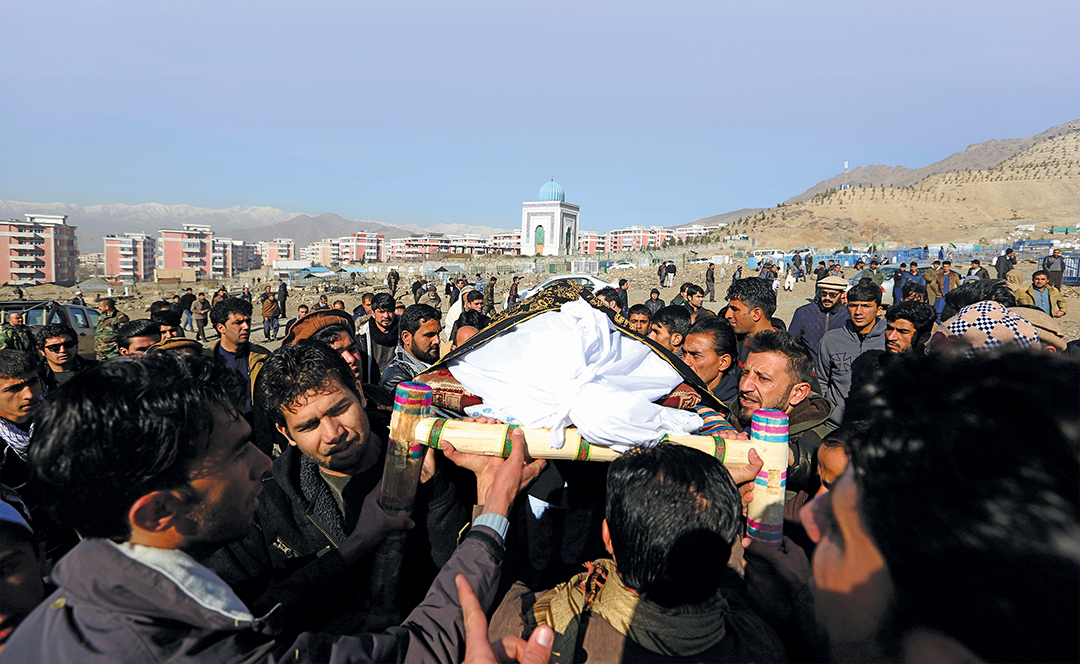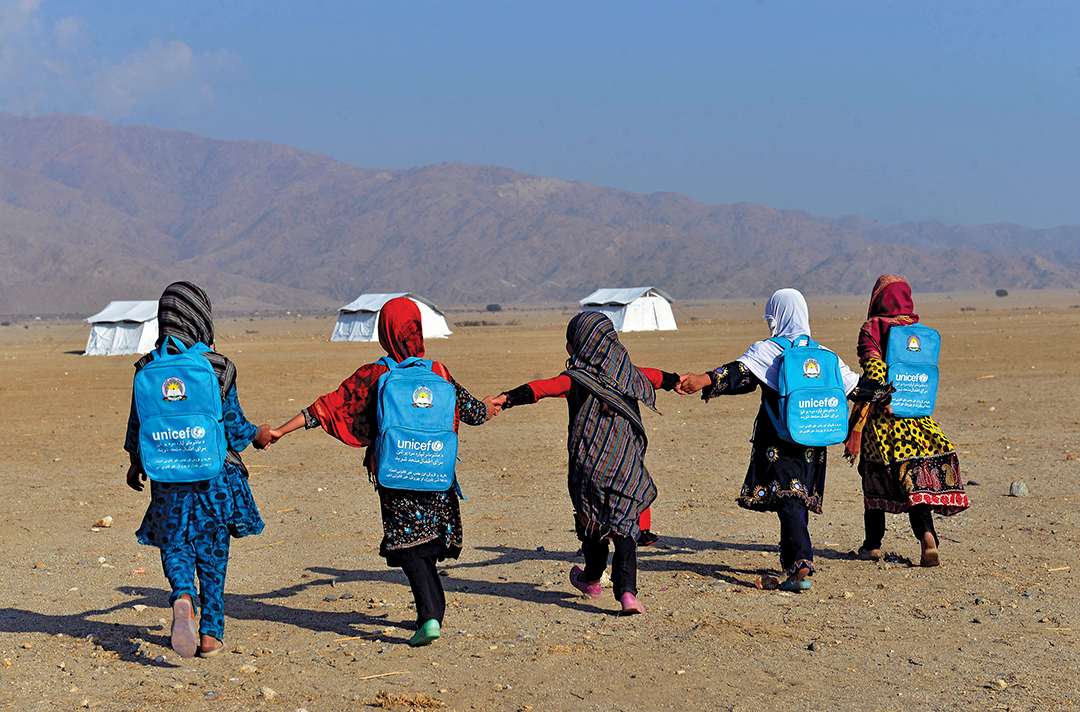Why regional cooperation in Afghanistan fails to deliver
Farid Osmanov Chevening Scholar at the University of Oxford, Blavatnik School of Government
Photos by The Associated Press
Cooperation platforms such as the Istanbul Process, the Tokyo Mutual Accountability Framework and the International Contact Group on Afghanistan were viewed by the international community as mechanisms for complementing military- and security-related tasks and contributing to building stability and prosperity in an Afghanistan saddled by decades of violence.
Yet such platforms have failed to produce meaningful outcomes. The “Great Game,” a term coined by Rudyard Kipling in the 19th century to describe the scramble for control of Central Asia among the great powers, has retained its meaning into the modern age and is reflected in the work of regional cooperation frameworks. Since then, international systems have been substantially modified, major powers have shifted their positions, and the number of regional players able to influence events has increased, unsettling alliances and the overall situation in the region. Although common ground for cooperation exists among some powers, it is still outweighed by the deep divergence of major players’ individual interests.
The United States
The U.S. involvement in Afghanistan, beginning in 2001, turned out to be costly and exhausting. The Obama administration made withdrawing troops from Iraq and Afghanistan one of its foreign policy priorities. However, the U.S. also expected to see the fruits of 15 years of prodigal spending. Afghanistan is crucial for ensuring American interests in greater Eurasia, yet the U.S. is not willing to continue spending vast sums. Therefore, regional cooperation mechanisms present a good tool for the U.S. to further its interests in a nondirect manner and at a lesser cost.
According to The Diplomat online magazine, Hillary Clinton, then-U.S. secretary of state, introduced the New Silk Road initiative in 2011. It was aimed at connecting Central and South Asian markets with Afghanistan and reinvigorating the regional economy. In 2013, Chinese President Xi Jinping initiated the Silk Road Economic Belt, a project aimed at tying Asia to Europe via a network of multimodal corridors. It was immediately deemed a competitor to the New Silk Road project. Although the project was largely considered a challenge to U.S. interests in the region, in March 2015, a U.S. deputy secretary of state said about the Silk Road Economic Belt: “We don’t see China’s involvement in Central Asia in zero-sum terms. Its development of infrastructure in Central Asia can be fully complementary to our own efforts.” This is an indication that the U.S., after spending many years in the region, has learned that unilateral actions with no concessions to other stakeholders require immense resources and bear little fruit.

That the U.S. does not regard China’s Silk Road Economic Belt as a competitor project reflects its current vision for the region — to create transregional transportation links to facilitate trade and forge economic empowerment. Since the basic rationale of both projects embraces this vision, the U.S. can support China’s initiative. This flexibility also demonstrates U.S. willingness to share responsibility for Afghanistan with others, especially when important strategic goals coincide. Cooperation with China does not substantially threaten U.S. interests and may lead to the attainment of strategic long-term objectives.
China
Cooperation also emboldens China to carry out its own agenda. China’s interests in Afghanistan are largely determined by the necessities of securing its western borders and preventing the province of Xinjiang from becoming a safe haven for Islamic extremists. Beijing is working to eventually root out the East Turkestan Islamic movement, which has connections to the Taliban. Stability in Xinjiang is important to Beijing’s economic structure and development vision. As markets in traditionally superior coastal China become more saturated and labor costs increase, more significance is placed on its inner and western regions. A shift of manufacturers farther inland, where there is an abundance of cheap labor, is unavoidable if China is to maintain its economic surge. It will also help with the problem of internal migration. In addition, the China-Kazakhstan oil and China-Turkmenistan gas pipelines pass through Xinjiang, attaching greater strategic importance to this region and making it critical to strengthen security. Thus a stable and secure Afghanistan is important for maintaining China’s security and for creating auspicious conditions for expanding its economic geography.
China has become distinctly proactive in regional affairs through greater engagement in regional cooperation mechanisms, such as the Conference on Interaction and Confidence Building Measures in Asia (CICA) and the Istanbul Process. In May 2014, it hosted the CICA Summit in Shanghai and is chair of the organization. China also hosted a ministerial conference on the Istanbul Process in October 2014 in Beijing. In addition, along with Russia, China heads the Shanghai Cooperation Organization (SCO). Recently, China began promoting its New Asian Security Concept, which is based on the principles of common, comprehensive, cooperative and sustainable security. This concept reflects China’s security vision in the region and underlines its readiness and capacity to be a leading party in designing the regional security cooperation infrastructure.
China has also noticeably broadened its bilateral relations and cooperation with Pakistan, an essential country for resolving issues in Afghanistan. The greatest enterprise among them is the China-Pakistan economic corridor megaproject, at an estimated cost of $46 billion, as reported by Al Jazeera. It is aimed at connecting Gwadar Port in southwestern Pakistan to Xinjiang province through a network of railroads, highways and pipelines, giving China access to the Indian Ocean and further expanding its economic influence.
Russia
Russia’s goals in Afghanistan and the regional cooperation framework in place are manifold and sometimes contradictory. First, given its current focus on Syria and economic woes at home, Moscow cannot afford to devote resources to Afghanistan. With the collapse of the Soviet Union, Russia no longer has a border with Afghanistan, but aims to maintain its historic strategic position in the region and exert influence through the former Soviet republics of Central Asia. Yet, not all of them are tractable allies of Russia. It takes a sufficient level of sophistication to deal with countries like Uzbekistan and Turkmenistan, the former growing more and more unyielding toward Russia and the latter pursuing neutrality as its official foreign policy course.
Russia purports to strengthen the positions of the regional security institutions to which it belongs, such as the Collective Security Treaty Organization and the SCO, and hence has greater say on regional issues. Its strategic aim is to ensure that these institutions have more leverage in constructing the Eurasian regional security environment. Russia also plans to broaden the geography of the Customs Union and Eurasian Economic Union and engage more broadly in regional economic affairs. This holds particular significance for Russia in light of its strained relations with the West and pivot to Eurasia. Therefore, Russia is suspicious of the progress of regional initiatives in which other players have an advantage in putting forth their own agenda. Implementation of projects such as the New Silk Road and the Silk Road Economic Belt are not in Russia’s interest, because they seek to create alternative infrastructure and facilitate shipments of goods via routes circumventing Russia. The success of these initiatives would empower Central Asian countries along the new transportation routes, turning them into transit countries and thereby loosening Moscow’s grip on them.

Yet Russia has a record of openly supporting some projects initiated by other stakeholders, not corresponding to its strategic goals in the region. For instance, in 2011 President Vladimir Putin, then prime minister of Russia, pledged to contribute $500 million to the CASA-1000 project, aimed at providing an electricity network among the Kyrgyz Republic, Tajikistan and Pakistan via Afghanistan, according to Eco-Business.com. Conventional logic suggests that successful implementation of this initiative is not in Russia’s interest, for it will lessen these post-Soviet countries’ energy dependence on Russia. Thus, the willingness to financially support this sort of project might be explained by Russia’s overriding interest in not being excluded from regional projects of high importance and a desire to exercise greater control over them.
Moscow’s desire to foster Sino-Russian cooperation should be viewed through the lens of its strained relations with the West and the need to have a role in regional projects led by China. Russia needs to offset the influence of China in Central Asia to preserve its historical position in the region, yet it lacks the economic leverage to achieve this goal. China has much to offer and is exponentially expanding cooperation with Central Asian countries via a number of economic projects, thereby winning more influence among these countries and diminishing Moscow’s influence. On May 8, 2015, Russia and China signed a joint declaration “on cooperation in coordinating the development of the Eurasian Economic Union (EEU) project and the Silk Road Economic Belt (SREB)” with a goal of combining these two projects. This demonstrates that Russia has no choice but to concede to Chinese influence in the region, while striving to remain a part of China-led initiatives.
On the other hand, Russia needs to counter narcotics trafficking and, above all, the spread of terrorism and extremism emanating from Afghanistan and Central Asia that threatens to transcend borders and cause serious headaches for Russia on its own soil. Russia’s dilemma is that it is necessary to have a stable and secure Afghanistan to avert the diffusion of these menaces, while Moscow is reluctant to spend on the maintenance of this security. Thus Russia paradoxically needs greater involvement from other powers capable of upholding peace and stability in the region so that Russia can pursue its agenda in a safe environment, while at the same time, it seeks to offset the influence of these very powers.
Pakistan and India
The policies of Pakistan and India toward Afghanistan stem from the nature of their relationships. Pakistan’s strategic interests are of great importance in defining the fate of Afghanistan. Conventional thought holds that the key to stability in Afghanistan lies anywhere other than Islamabad. The porous and largely unmonitored border creates favorable conditions for infiltration and regrouping of extremist fighters from both sides. Pakistan wants to retain its excessive leverage over Afghanistan and fill the security vacuum after the withdrawal of NATO-led forces, similar to what happened after the retreat of Soviet troops from the region more than two decades ago and the subsequent curtailment of U.S. engagement.
Another widely articulated notion — frequently pronounced even on an official level — is that Pakistan supports Taliban fighters and encourages the division of Afghan society along ethnic lines. As Al Jazeera reported, beginning in 2015 the leadership of Afghanistan has repeatedly accused Pakistan of supporting the Taliban. One must also consider discrepancies within the power structure of Pakistan, when the views and official rhetoric of civilian leadership do not coincide with the actions of military leadership. Pakistan’s importance in Afghan affairs is further supported by Pakistan being one of the only countries, along with Saudi Arabia, capable of brokering negotiations between the Taliban and the Afghan government.
Pakistan seeks to maintain its ability to unilaterally influence the course of events in Afghanistan, and enhancement of India-Afghanistan relations does not serve this end. Pakistan is utterly against the perception in Afghanistan of a friendly India and dreads an improvement of relations between the two states. Pakistan is apprehensive about India increasing its economic influence over Afghanistan and strives to prevent this from happening. For instance, it does not give any transit rights to India for exports to the Afghan market.
A stable and prosperous Afghanistan is in India’s best interest. India’s prime objective is to mitigate terrorism and extremism threats coming from Afghanistan and Pakistan. India continues to invest in Afghanistan despite high security risks. India takes an active part in economic and trade initiatives within the format of regional cooperation. India also signed a preferential trade agreement with Afghanistan and lifted tariffs on imported Afghan goods.

The strategic postures of India and Pakistan toward Afghanistan align India with Iran, while Pakistan is aligned with China on one side and Saudi Arabia on the other. Cooperation between Iran and India became particularly noteworthy due to India’s heightened interest in and financial contributions to the Chabahar Port project in Iran, which will facilitate faster shipment of goods from India to Iran, bypassing Pakistan. This is an essential project for India, considering Pakistan does not allow India to use Pakistani territory for economic purposes and thus prevents its economic expansion in the region. This project is also widely seen as aimed to balance the China-Pakistan economic corridor project. The Iran-India, China-Pakistan and Saudi Arabia-Pakistan alignments, and cooperation on large-scale projects, demonstrate that the deep divergence of interests between Pakistan and India necessitates that each seek favorable partners and pursue certain projects to attain their objectives.
Iran
Iran is an important player in regional affairs with a capacity to exert influence over Afghanistan, particularly in the western province of Herat. A linguistic affinity, the fact that 20 percent of Afghanistan’s population belongs to the Shia branch of Islam, and the estimated 3 million Afghan refugees residing in Iran are among the important factors Iran may leverage. Iran’s recent nuclear deal with the international community, resulting in the lifting of sanctions, further contributes to its more assertive policy in Afghanistan and the region.
An ever-increasing number of sources claim that Iran gives material and arms support to the Taliban, its implacable foe, to curb the spread of ISIS, a claim Tehran resolutely denies, according to a June 2015 article in Foreign Affairs. Such possibilities must be considered in the context of the broader animosity between Iran and Saudi Arabia. It may further escalate the situation and threatens to turn Afghanistan into a new theater of Shia-Sunni sectarian violence, similar to that observed in the Middle East.
Afghanistan faces a serious dilemma as it aims to deepen cooperation with Iran, particularly for economic reasons, while retaining close relations with the Saudis, who have considerable influence over the Taliban. Saudi Arabia, in return, expects Afghanistan to join a broad Sunni coalition, which undoubtedly will cause a backlash from Iran. Thus the government of Afghanistan must be vigilant and balanced in its dealings with both, as overt inclinations toward one may trigger external support to sectarianism and deteriorate the already fragile security environment in the country.
Conclusion
This imbroglio of divergent interests and strategic goals of global and regional powers, and their alignments with other like-minded stakeholders, leads to the degradation of security in Afghanistan and dampens the prospects for stability and prosperity. It also makes the regional cooperation platforms created to reinvigorate Afghanistan superfluous and inefficient. The increased focus of the international community on the Middle East and problems emanating from there diverts attention from Afghanistan. The situation is further strained by the ongoing Iran-Saudi Arabia enmity, the resurgence of the Taliban, the emergence of ISIS and potential external support for these radical groups.
The likelihood of these militant groups filling the security gap and challenging the authority of the central government is extremely high. The decrease in NATO-led troops has already resulted in a vacuum in the country’s security and put its security institutions to a serious test. The complete withdrawal of coalition forces will only deteriorate the situation, setting a propitious ground for a wider resurgence of radicalism and militancy, undercutting the positive results achieved during the past decade. Hence, greater attention from the international community and, foremost, greater coordination of projects and crafting of a unified approach among global and regional players in Afghanistan is essential to keeping the country off the path to violence and instability.


Comments are closed.